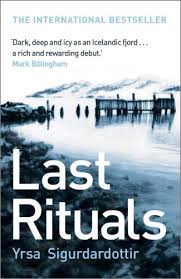Last Rituals by Yrsa Sigurdardottir, Iceland, 2005
 A murder mystery set in Iceland and threaded through with stories of witchcraft and sorcery, Last Rituals is an easy-to-read page turner that is likely to have wide popular appeal. That said, the writing itself is nothing out of the ordinary, but whether this is due to Sigurdardottir’s writing style or to her translator is difficult to say.
A murder mystery set in Iceland and threaded through with stories of witchcraft and sorcery, Last Rituals is an easy-to-read page turner that is likely to have wide popular appeal. That said, the writing itself is nothing out of the ordinary, but whether this is due to Sigurdardottir’s writing style or to her translator is difficult to say.
The murder victim, Harald, is a German history student, studying in Iceland. Mainly interested in witchcraft in Iceland during the sixteenth and seventeenth centuries, he uses his studies and research to help him locate not only several important historical documents but also a copy of Malleus Maleficarum. He also finds an ancient curse, which he plans to use on his mother after his death.
Harald is surrounded by a number of students from the university, all of whom are involved in the ‘dark arts’, and none of whom are particularly likeable or intelligent. After the grisly murder, Thóra Gudmundsdóttir, divorced mother of two and a lawyer by profession, is contacted by Harald’s family to find out who murdered him and why. The family is less than satisfied with the job the police are doing and they hope that Thóra will be more successful. The link between Harald’s family in Germany and Thóra in Iceland is Matthew Reich.

I found Matthew to be quite unpleasant and his complete personality turnaround in the latter part of the book is difficult to believe. In fact, much of the story is difficult to believe. That said, Sigurdardottir has definitely done a lot of research into the history behind the story, but at times I felt that the emphasis on historical facts both watered down and waylaid any suspense that may have surrounded questions such as: Why was Harald murdered? Who murdered him? What did he have against his family?

The Guardian wrote: ‘. . . this is a surprisingly funny book. . .’. Perhaps we read different books or else our sense of humour is different. Except for a few humorous comments by Thóra near the end of the book, I would not call this a ‘funny book’. Apart from the historical background (which is, at times, quite interesting) the characters and the story itself are surprisingly unpleasant, even inane. However, that said, I am well aware that we all relate to books differently, and a book that may have little appeal for one person may be considered a favourite by someone else. I suggest, if you find the subject interesting, that you read the book and decide for yourself; after all, Yrsa Sigurdardottir is considered by many to be the ‘Queen of Icelandic crime’. Mirroring my own feelings about the translation, the Kirkus Review of the book concludes with the following: “Some of the nuances seem to have been lost in translation, but the meat of the mystery is suspenseful, compelling and unique.”
The image of Yrsa Sigurdottir is from nationalcentreforwriting.org.uk
The image of Malleus Maleficarum is from amazon.com
The image of the Iceland university is from topuniversities.com